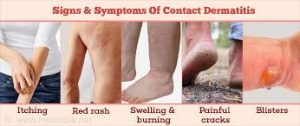Call Today to Schedule an Appointment: 212-319-5282
Contact Dermatitis
What is Contact Dermatitis?
Have you experienced any type of weird rash or skin irritation after using a new kind of detergent or skincare product? Well, if that’s so, then it was probably a form of contact dermatitis. While many people may be suffering or have suffered from contact dermatitis at one time, not everybody knows its exact cause and symptoms. In this article, we’re going to address some of the symptoms of the condition, how it can be treated, and what it is exactly.
What is Contact Dermatitis?
Contact dermatitis, as its name implies, is a violent skin reaction that occurs when certain irritants enter in contact with the skin. There are mainly 3 types of contact dermatitis: irritant contact dermatitis, allergic contact dermatitis and photo contact dermatitis.
Allergic contact dermatitis is when the skin enters into contact with a foreign element and has an allergic reaction. This can be anything from gold or nickel jewelry, chemicals or perfumes, latex gloves or elements like poison ivy and poison oak.
Irritant contact dermatitis is when an irritant enters in contact with the skin, such as bleach, battery acid, drain cleaners and other cleaning products.
Photo contact dermatitis is rarer and occurs when certain chemicals found in skincare and body treatments become irritants after being exposed to the sun.
What are the Symptoms of Contact Dermatitis?
 In the case of allergic contact dermatitis, you might start seeing hives, scaly, flaky or dry skin, skin redness, oozing blisters, darkened or leathery skin, burning skin or extreme itching. You might also become more sensitive to sunlight.
In the case of allergic contact dermatitis, you might start seeing hives, scaly, flaky or dry skin, skin redness, oozing blisters, darkened or leathery skin, burning skin or extreme itching. You might also become more sensitive to sunlight.
When it comes to irritant contact dermatitis, you might see blistering, swelling, ulcerations, tight or stiff skin, extreme dryness resulting in cracking skin and open sores forming crusts.
What are the Treatments for Contact Dermatitis?
In most cases, symptoms will go away after a while when you stop contact with the irritant. If you’re suffering from irritant contact dermatitis, then you should first refrain from scratching your skin. This can actually make the problem worse and may result in infections which will only be treatable through antibiotics.
You’ll need to clean the area with lukewarm water and mild soap to get rid of the irritants. Identify any products you feel might be at cause and stop using them. You could also treat the area with calamine lotion, cortisol or hydrocortisone cream. An over the counter antihistamine may also reduce symptoms if you’re dealing with an allergic reaction.
However, while most cases of contact dermatitis will subside after a while, it would be wise to see a doctor if the condition is affecting a large portion of your body, is close to your mouth or eyes, or doesn’t stop after treatment.
If you suffer from contact dermatitis, contact us today to schedule an appointment with the best allergist in New York
Serving all of New York City and the Tri State Area including Zip Codes: Top Allergist NYC Midtown, Chelsea and Clinton: 10001, 10011, 10018, 10019, 10020, 10036 | Gramercy Park and Murray Hill: 10010, 10016, 10017, 10022 | Greenwich Village and Soho: 10012, 10013, 10014 | Lower Manhattan: 10004, 10005, 10006, 10007, 10038, 10280 | Lower East Side: 10002, 10003, 10009 | Upper East Side: 10021, 10028, 10044, 10128 | Upper West Side: 10023, 10024, 10025
